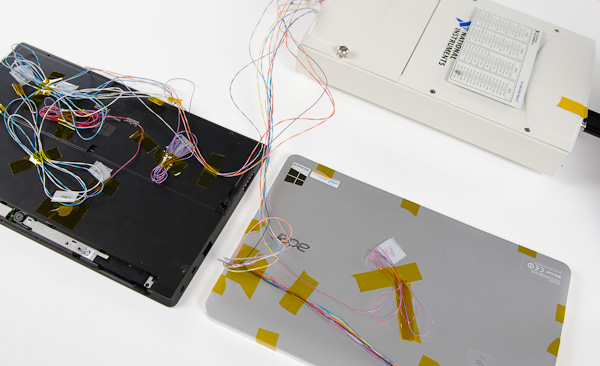The x86 Power Myth Busted: In-Depth Clover Trail Power Analysis
by Anand Lal Shimpi on December 24, 2012 5:00 PM ESTFinal Words
Ultimately I don't know that this data really changes what we already knew about Clover Trail: it is a more power efficient platform than NVIDIA's Tegra 3. I summed up the power consumption advantage in the table below (I left out the GPU numbers since I'm not totally clear with what NVIDIA attaches to the GPU power rail on Tegra 3):
| Power Consumption Comparison | ||||||||
| Surface RT | W510 | Surface RT (CPU) | W510 (CPU) | |||||
| Idle | 3.182W | 2.474W | 70.2mW | 36.4mW | ||||
| Cold Boot | 5.358W | 3.280W | 800mW | 216mW | ||||
| SunSpider 0.9.1 | 4.775W | 3.704W | 722mW | 520mW | ||||
| Kraken | 4.738W | 3.582W | 829mW | 564mW | ||||
| RIABench | 3.962W | 3.294W | 379mW | 261mW | ||||
| WebXPRT | 4.617W | 3.225W | 663mW | 412mW | ||||
| TouchXPRT (Photo Enhance) | 4.789W | 3.793W | 913mW | 378mW | ||||
| GPU Workload | 5.395W | 3.656W | 1432mW | 488mW | ||||
Across the board Intel manages a huge advantage over NVIDIA's Tegra 3. Again, this shouldn't be a surprise. Intel's 32nm SoC process offers a big advantage over TSMC's 40nm G used for NVIDIA's Cortex A9 cores (the rest of the SoC is built on LP, the whole chip uses TSMC's 40nm LPG), and there are also the architectural advantages that Atom offers over ARM's Cortex A9. As we've mentioned in both our Medfield and Clover Trail reviews: the x86 power myth has been busted. I think it's very telling that Intel didn't show up with an iPad for this comparison, although I will be trying to replicate this setup on my own with an iPad 4 to see if I can't make it happen without breaking too many devices. We've also just now received the first Qualcomm Krait based Windows RT tablets, which will make another interesting comparison point going forward.
Keeping in mind that this isn't Intel's best foot forward either, the coming years ahead should provide for some entertaining competition. In less than a year Intel will be shipping its first 22nm Atom in tablets, while NVIDIA will quickly toss Tegra 3 aside in favor of the Cortex A15 based 28nm Wayne (Tegra 4?) SoC in the first half of next year. Beating up on Surface RT today may be fun for Intel, but next year won't be quite as easy. The big unknown in all of this is of course what happens when Core gets below 10W. Intel already demonstrated Haswell at 8W - it wouldn't be too far fetched to assume that Intel is gunning for Swift/Cortex A15 with a Core based SoC next year.
Here's where it really gets tricky: Intel built the better SoC, but Microsoft built the better device - and that device happens to use Tegra 3. The days of Intel simply building a chip and putting it out in the world are long gone. As it first discovered with Apple, only through a close relationship with the OEM can Intel really deliver a compelling product. When left to their own devices, the OEMs don't always seem to build competitive devices. Even despite Intel's significant involvement in Acer's W510, the tablet showed up with an unusable trackpad, underperforming WiFi and stability issues. Clover Trail has the CPU performance I want from a tablet today, but I want Apple, Google or Microsoft to use it. I do have hope that the other players will wake up and get better, but for next year I feel like the tune won't be any different. Intel needs design wins among the big three to really make an impact in the tablet space.
The good news is Microsoft is already engaged with Surface Pro. It's safe to bet that there will be a Haswell version coming as well. Now Intel just needs an iPad and a Nexus win.











163 Comments
View All Comments
vvv - Wednesday, January 2, 2013 - link
Idle power comparisons on a sample size of one should not count. You would think that binning makes all samples look alike but you will be surprised.Wolfpup - Thursday, January 3, 2013 - link
This is just so impressive...since at least the late 90's I've been wanting exactly this-an actual x86 PC in a mobile form factor. And...it's actually here.Heck, this Atom could go in today's CELL phones no problem (the bigger, higher end ones anyway). It's better than Vita's CPU (although granted, wasn't available at the time).
An actual tablet that can be SMALLER than ARM tablets even, real Windows, real x86...same price. Soooo impressive!
Granted the hardware will keep getting better and the software kinks will get worked out, but...it's actually happening!
shriganesh - Saturday, February 9, 2013 - link
Very nice comparison! x86 does seem to be very power efficient! Except the Tegra 3's companion core isn't working. Compare an x86 Android tablet/phone with ARM tablet/phone. That will be more of an apple to apple comparison.All the guys rooting for Intel. Beware! Intel crushed AMD with Core CPUs. But when AMD lost the battle, there were no more moderately priced intel CPUs! Intel is like Apple! They always charge a premium.
I hope Intel looses to the armada of ARM CPU designers (Samsung, nVidia, Quailcomm) just for the sake of cheap CPUs. With the world heading towards internet of everything, the last thing we need is COSTLY intel CPUs!